How to choose a houseplant?
Bringing home a plant for the first time is both; a responsibility as well as an opportunity. When you take care of a plant, a plant takes care of you in many ways too. This happy relationship should be sustained right from the beginning.
More than often, we all end up buying plants which we find attractive or on sale. The key to buying a houseplant is not always dependent on its physical attributes or its benefits, rather a perfect combination of both of these combined with a thorough understanding of the surroundings for your plant.

Let us get you started on choosing the right houseplant for you.
The foremost factor to be considered is space.
Choose where you want to keep your plant and then continue the process of purchase. Deciding where your plant would go after you’ve purchased it is the wrong way to go about it. The size, the type and even the lifespan of the plant are dependent on this. The plant needs its own space to breathe.
- Trying too hard to fit in plants in a corner will hinder their flow of air. Good airflow helps them to survive longer with healthier foliage & longer stems. It also reduces humidity and reduces the risk of diseases.
- Places with better airflow such as hallways, window sides and even table tops help plants thrive better.
- Maintaining a space of 6” between any other surface or furniture and your plants is considered ideal.
- If it is going to be a room with no windows or natural light supply, try and bring the plant in contact with the same once in a while.
The second most crucial factor affecting your decision is lighting.
While natural lighting is the main source that plants need, the degree of the same affects different plants, differently.
- Places with full sun, mostly experienced through south facing windows, can be too harsh for some and manageable for others. Mostly succulents are the ones that can thrive in full sun.
- There are spaces with next to perfect combination, i.e., partial sun and shade. Such spots receive direct sunlight for some hours of the day and then are left with only the shade. Flowering plants survive & grow the best in this situation.
- The next category is the one with partial light or full shade. Most of the plants resist these conditions and die easily. But there are some plants like the Snake plant, Spider plant or the Zz plant that can easily grow in these conditions and low-maintenance as well.
- Then, there are spaces which are bright but blessed with indirect sunlight only. This is the ideal situation required by most of your foliage and flowering plants. This kind of space gives you much more liberty to choose from a wide-variety of plants available.
The next determining factor for you to choose your next houseplant is the temperature of your room. A plant’s survival rate is only as good as its ecosystem. While the dependency of a houseplant is greater than that of an outdoor plant, these factors still fall in our control unlike those for the outdoor plants. The temperature of the room directly affects the growth & stiffness of your plant.
- While spring & summer room temperatures are ideal for your houseplants, the other seasons can be a bit demanding.
- The presence of artificial room temperature controlling mechanisms such as the air conditioner or the heater also affect your plant. While air conditioners slow the process of the plant’s soil to dry, heaters will accelerate the same.-
- The key lies in the balance in this case. Observe how your plant reacts to different temperatures and make adjustments accordingly.
The quality of your plant & the soil it was planted in also affects the growth of your plant. It is always better to go for home-grown plants from a trusted brand/store rather than buying them as a mere decor piece. A mindful decision taken before the purchase will help you sustain the purchase for longer.
We hope that these tips did help you. Write to us in the comments section and let us know how you chose your first houseplant or in case of any troubles you may have with your plants.













